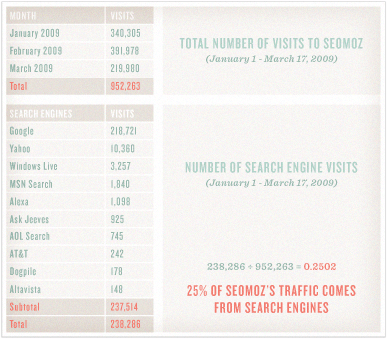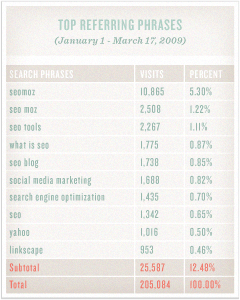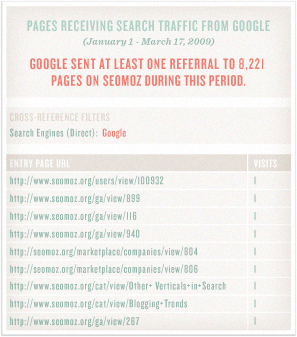They say that if you can measure it, then you can improve it. In search engine optimization, measurement is critical to success. Professional SEOs track data about rankings, referrals, links, and more to help analyze their SEO strategy and create road maps for success.
RECOMMENDED METRICS TO TRACK
Although every business is unique, and every website has different metrics that matter, the following list is nearly universal. Here we're covering metrics critical to SEO; more general metrics are not be included. For a more comprehensive look at web analytics, check outChoosing Web Analytics Key Performance Indicators by Avinash Kaushik.
1. Search Engine Share of Referring Visits
Every month, keep track of the contribution of each traffic source for your site, including:
- Direct Navigation: Typed in traffic, bookmarks, email links without tracking codes, etc.
- Referral Traffic: From links across the web or in trackable email, promotional, and branding campaign links
- Search Traffic: Queries that sent traffic from any major or minor web search engine
Knowing both the percentage and exact numbers will help you identify weaknesses and give you a basis for comparison over time. For example, if you see that traffic has spiked dramatically but it comes from referral links with low relevance, it's not time to get excited. On the other hand, if search engine traffic falls dramatically, you may be in trouble. You should use this data to track your marketing efforts and plan your traffic acquisition efforts.

2. Search Engine Referrals
Three major engines make up 95%+ of all search traffic in the US: Google and the Yahoo!-Bing alliance. For most countries outside the US, 80%+ of search traffic comes solely from Google (with a few notable exceptions including Russia and China). Measuring the contribution of your search traffic from each engine is useful for several reasons:
Compare Performance vs. Market Share
Compare the volume contribution of each engine with its estimated market share.
Get Visibility Into Potential Drops
If your search traffic should drop significantly at any point, knowing the relative and exact contributions from each engine will be essential to diagnosing the issue. If all the engines drop off equally, the problem is almost certainly one of accessibility. If Google drops while the others remain at previous levels, it's more likely to be a penalty or devaluation of your SEO efforts by that singular engine.
Uncover Strategic Value
It's very likely that some efforts you undertake in SEO will have greater positive results on some engines than on others. For example, we've observed that on-page optimization tactics like better keyword inclusion and targeting reap greater benefits with Bing and Yahoo! than with Google. On the other hand, gaining specific anchor text links from a large number of domains has a more positive impact on Google than the others. If you can identify the tactics that are having success with one engine, you'll better know how to focus your efforts.
3. Visits Referred by Specific Search Engine Terms and Phrases
The keywords that send traffic are another important piece of your analytics pie. You'll want to keep track of these on a regular basis to help identify new trends in keyword demand, gauge your performance on key terms, and find terms that are bringing significant traffic that you're potentially under-optimized for.
You may also find value in tracking search referral counts for terms outside the top terms and phrases—those that are most valuable to your business. If the trend lines are pointing in the wrong direction, you know efforts need to be undertaken to course-correct. Search traffic worldwide has consistently risen over the past 15 years, so a decline in the quantity of referrals is troubling. Check for seasonality issues (keywords that are only in demand certain times of the week/month/year) and rankings (have you dropped, or has search volume ebbed?).

4. Conversion Rate by Search Query Term/Phrase
When it comes to the bottom line for your organization, few metrics matter as much as conversion. For example, in the graphic to the right, 5.80% of visitors who reached Moz with the query "SEO Tools" signed up to become members during that visit. This is a much higher conversion rate than most of the thousands of keywords used to find our site. With this information, we can now do two things:
- Checking our rankings, we see that we only rank #4 for "SEO Tools." Working to improve this position will undoubtedly lead to more conversion.
- Because our analytics will also tell us what page these visitors landed on (mostly https://moz.com/tools), we can focus our efforts on improving the visitor experience on that page.
The real value from this simplistic tracking comes from the low-hanging fruit: finding keywords that continually send visitors who convert to paying customers, and increasing focus on rankings and on improving the landing pages that visitors reach. While conversion rate tracking from keyword phrase referrals is certainly important, it's never the whole story. Dig deeper and you can often uncover far more interesting and applicable data about how conversion starts and ends on your site.

5. Number of pages receiving at least one visit from search engines
Knowing the number of pages that receive search engine traffic is an essential metric for monitoring overall SEO performance. From this number, we can get a glimpse into indexation—the number of pages from our site the engines are keeping in their indexes. For most large websites (50,000+ pages), mere inclusion is essential to earning traffic, and this metric delivers a trackable number that's indicative of success or failure. As you work on issues like site architecture, link acquisition, XML sitemaps, and uniqueness of content and meta data, the trend line should rise, showing that more and more pages are earning their way into the engines' results. Pages receiving search traffic is, quite possibly, the best long tail metric around.
While other analytics data points are of great importance, those mentioned above should be universally applied to get the maximum value from your SEO campaigns.

Google's (not provided) Keywords
In 2011, Google announced it would no longer pass keyword query data through its referrer string for logged-in users. This meant that instead of showing organic keyword data in Google Analytics, visits from users logged into Google would show the keyword query as "(not provided)." At the time, Google said they expected this to affect less than 10% of all search queries. But soon webmasters reported up to 20% of their search queries were from keywords (not provided).
Over the ensuing two years, webmasters began reporting much higher volumes of (not provided) keywords as more and more searched were performed using encrypted search (i.e., the https:// version of Google). With the launch of Google+, more logged-in users pushed this number even higher. Over time, smart SEOs have identified methods to contend with the (not provided) situation, and tips on reclaiming your data.
| ||
Analytics Software
The right rools for the job

Additional Reading:
- How to Choose a Web Analytics Tool: A Radical Alternative from Avinash Kaushik way back in 2006 (but still a relevant and quality piece)

- Yahoo! Web Analytics(formerly Indextools)
- Google Analytics
- Clicky Web Analytics
- Piwik Open Source Analysis
- Woopra Website Tracking
- AWStats
Choosing can be tough. We're partial to Moz Analytics because we built it from the ground up to provide the broadest suite of SEO tools available, and give you all of your inbound marketing data in one place. For free tools, our top recommendation is Google Analytics. Because of its broad adoption you can find many tutorials and guides available online. Google Analytics also has the advantage of cross-integration with other Google products such as Webmaster Tools, AdWords, and AdSense.
No matter which analytics software you select, we strongly recommend testing different versions of pages on your site and making conversion rate improvements based on the results. Testing pages on your site can be as simple as using a free tool to test two versions of a page header or as complex as using an expensive multivariate software to simultaneously test hundreds of variants of a page.
Metrics for Measuring
Search Engine Optimization
It's difficult to optimize for specific behaviors of search engines, because their algorithms aren't public. But a combination of tactics has proven effective, and new data is always emerging to help track the variables that influence ranking, and fluctuations in ranking signals. You can even use the search engines themselves to gain a competitive advantage by structuring clever queries and by utilizing data the engines have published. You can employ what you learn from these techniques, in concert with quality analytics software and SEO education, to formulate an action plan for optimizing your website.


Google Site Query
Restrict your search to a specific site (e.g., site:moz.com). Useful to see the number and list of pages indexed on a particular domain. You can expand the value by adding additional query parameters. For example, site:moz.com/blog inurl:tools, will show only those pages in Google's index that are in the blog and contain the word "tools" in the URL. This number will fluctuate, but it's a decent rough measurement (learn more from this blog post).
Google Trends
At google.com/trends, you can research keyword search volume and popularity over time. Log in to your Google account to get richer data, including specific numbers instead of simple trend lines.

Bing Site Query
Restrict your query to a specific site (e.g., site:moz.com). Just like Google, Bing allows for queries to show the number and list of pages in their index from a given site. Be advised that Bing's counts are given to considerable fluctuation, which may limit the utility of the data.
Bing IP Query
Restrict your query to a specific IP address (e.g., ip:216.176.191.233). This query will show pages that Microsoft's engine has found on the given IP address. This can be useful to identify whether a page is hosted on a shared provider, or to find sites hosted the same IP.
Bing Ads Intelligence
Bing Ads Intelligence has a variety of keyword research and audience intelligence tools, primarily intended for search and display advertising. This guide won't dive deep into the value of each individual tool, but they are worth investigating and many can be applied to SEO.

Blog Search Link Query
Search links in a blog (e.g., link:https://moz.com/blog). Google's regular link query operator is not always useful, but their blog search generally yields high-quality results, sortable by date range and relevance. Learn more about the link operator in thisblog post.
Page Specific Metrics
Page Authority - Page Authority predicts the likelihood that a single page will rank well, regardless of its content. The higher the Page Authority, the greater the potential for that individual page to rank.
MozRank - MozRank, part of Moz's Open Site Explorer, refers to Moz’s general, logarithmically scaled 10-point measure of global link authority (or popularity). MozRank is very similar in purpose to the measures of static importance (which means importance independent of a specific query) that are used by the search engines (e.g., Google's PageRank or FAST's StaticRank). Search engines often rank pages with higher global link authority ahead of pages with lower authority. Because measures like MozRank are global and static, this ranking power applies to a broad range of search queries, rather than pages optimized specifically for a particular keyword.
MozTrust - Another component of Open Site Explorer, MozTrustis distributed through links. First, trustworthy seed sites are identified to feed the calculation of the metric; these include major international university, media, and governmental websites. Websites that earn links from the seed set are then able to cast (lesser) trust-votes through their links. This process continues across the web and the MozTrust of each applicable link decreases as its distance from the seed sites increases.
Number of Links - The total number of pages that contain at least one link to a page, with a maximum of one qualifying link per page. For example, if the Library of Congress homepage (http://www.loc.gov/index.html) linked to the White House's homepage (http://www.whitehouse.gov) in both the page content and the footer, this would be counted as a single link.
Number of Linking Root Domains - The total number of unique root domains that contain a link to a page, with a maximum of one qualifying link per domain. For example, if topics.nytimes.com and www.nytimes.com both linked to the homepage of Moz (https://moz.com), this would count as a single linking root domain.
External MozRank - Whereas MozRank measures the link juice (ranking power) of both internal and external links, external MozRank measures only the amount of MozRank flowing through external links (links located on a separate domain). Because external links can play an important role as independent endorsements, external MozRank is an important metric for predicting search engine rankings.
Domain Specific Metrics
Domain Authority - Domain Authority predicts how well a web page on a specific domain will rank. The higher the Domain Authority, the greater the potential for an individual page on that domain to rank well.
Domain MozRank - Domain-level MozRank (DmR) quantifies the popularity of a given domain compared to all other domains on the web. DmR is computed for both subdomains and root domains. This metric uses the same algorithm as MozRank but applies it to the domain-level link graph, a view of the web that only looks at domains as a whole and ignores individual pages. Viewing the web from this perspective offers additional insight about the general authority of a domain. Just as pages can endorse other pages, a link that crosses domain boundaries (e.g., from a page on searchengineland.com to a page on https://moz.com) can be seen as an endorsement of one domain by another.
Domain MozTrust - Just as MozRank can be applied at the domain level (Domain-level MozRank), so can MozTrust. Domain-level MozTrust is like MozTrust but instead of being calculated between web pages, it is calculated between entire domains. New or poorly linked-to pages on highly trusted domains may inherit some natural trust by virtue of being hosted on the trusted domain. Domain-level MozTrust is expressed on a 10-point logarithmic scale.
Number of Links - The quantity of pages that contain at least one link to the domain. For example, if http://www.loc.gov/index.html and http://www.loc.gov/about both contained links to http://www.nasa.gov, this would count as two links to the domain.
Number of Linking Root Domains - The quantity of different domains that contain at least one page with a link to any page on the site. For example, if http://www.loc.gov/index.html and http://www.loc.gov/about both contained links to http://www.nasa.gov, this would count as only a single linking root domain to nasa.gov.
APPLYING THAT DATA
Just knowing the numbers won't help unless you can effectively interpret and apply changes to course-correct. Below, we've taken a sample of some of the most common directional signals obtained by tracking data points and offered suggestions on how to capitalize on and respond to them.
Fluctuation
In search engine page and link count numbers
The numbers reported in "site:" and "link:" queries are rarely precise, so we caution against getting too worried about large fluctuations unless they are accompanied by traffic drops. For example, on any given day, Yahoo! reports between 800,000 and 2,000,000 links to the moz.com domain. Obviously, we don't gain or lose hundreds of thousands of links each day, so this variability provides little guidance about our actual link growth or shrinkage.
If drops in links or pages indexed coincide with traffic referral drops from the search engines, you may be experiencing a real loss of link juice (check to see if important links that were previously sending traffic/rankings boosts still exist) or a loss of indexation due to penalties, hacking, or malware. A thorough analysis using your own web analytics and Google's Webmaster Tools can help to identify potential problems.
Falling
Search traffic from a single engine

Identify the problem most likely to be the culprit and investigate. Visit forums like Cre8asite, HighRankings, and Google’s Groups for Webmasters for help.
| ||
Falling
Search traffic from multiple engines
Chances are good that you've done something on your site to block crawlers or stop indexation. This could be something in the robots.txt or meta robots tags, a problem with hosting/uptime, a DNS resolution issue, or a number of other technical breakdowns. Talk to your system administrator, developers, or hosting provider, and carefully review your Webmaster Tools accounts and analytics to help determine potential causes.
Individual
Ranking fluctuations
Gaining or losing rankings for one or more terms or phrases happens millions of times a day to millions of pages and is generally nothing to be concerned about. Ranking algorithms fluctuate, competitors gain and lose links (and on-page optimization tactics), and search engines even flux between indexes (and may sometimes even make mistakes in their crawling, inclusion, or ranking processes). When a dramatic rankings decrease occurs, you might want to carefully review on-page elements for any signs of over-optimization or violation of guidelines (cloaking, keyword stuffing, etc.) and check to see if links have recently been gained or lost. Note that with sudden spikes in rankings for new content, a temporary period of high visibility followed by a dramatic drop is common; in the SEO field, we refer to this as the "freshness boost".
"Don't panic over small fluctuations. With large drops, be wary against making a judgment call until at least a few days have passed. If you run a new site or are in the process of link acquisition and active marketing, these sudden spikes and drops are even more common, so simply be prepared and keep working."
Positive
Increases in link metrics without rankings increases
Many site owners assume that when they've done some classic SEO—on-page optimization, link acquisition, etc.—they can expect instant results. This, sadly, is not the case. Particularly for new sites, pages, and content that have heavy competition, ranking improvements take time. Even earning lots of great links is not a sure recipe to instantly reach the top. Remember that the engines not only have to crawl all those pages where you've acquired links, but also index and process them. So the metrics and rankings you're seeking may be days or even weeks behind the progress you've made.
Source: Moz
Author: Bryan Granse
Contact: Click Me










